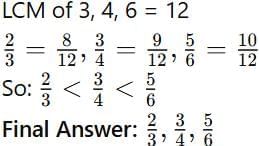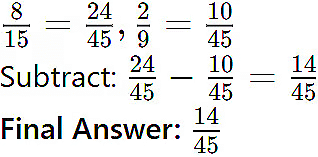Practice Questions: Working with Fractions | Mathematics (Ganita Prakash) Class 7 - New NCERT PDF Download
Q1. Mark has 3/4 kg of flour and uses 1/8 kg for each cookie batch. How many batches can he make?
Sol:
Total flour = 3/4 kg
Flour per batch = 1/8 kg
Number of batches = Total flour ÷ Flour per batch
= (3/4) ÷ (1/8)
= (3/4) × (8/1)
= (3 × 8) / 4
= 24 / 4
= 6
Q2. A string of 4/7 meter is cut into 8 equal pieces. What is the length of each piece?
Sol:
Total length = 4/7 meter
Number of pieces = 8
Length per piece = Total length ÷ Number of pieces
= (4/7) ÷ 8
= (4/7) × (1/8)
= 4 / 56
= 1 / 14 meter
Q3. Simplify: (3/4) × (8/9) ÷ (2/3)
Sol:
Perform multiplication and division from left to right:
(3/4) × (8/9)
= (3 × 8) / (4 × 9)
= 24 / 36
= 2 / 3
(2/3) ÷ (2/3)
= (2/3) × (3/2)
= (2 × 3) / (3 × 2)
= 6 / 6
= 1
Q4. Each side of a square tile is 3/4 meter. Find its area.
Sol:
Area of a square = side × side
Side = 3/4 meter
Area = (3/4) × (3/4) = 9 / 16 m2
Q5. A printer can print 2/3 pages in one minute. How many minutes will it take to print 8/5 pages?
Sol:
Pages per minute = 2/3
Total pages to print = 8/5
Time required = Total pages ÷ Pages per minute
= (8/5) ÷ (2/3)
= (8/5) × (3/2)
= (8 × 3) / (5 × 2) = 24 / 10 = 12 / 5 minutes.
Q6. Divide the sum of 5/6 and 2/3 by 3/4.
Sol:
Sum of fractions:
5/6 + 2/3 = 5/6 + 4/6 = 9/6 = 3/2
Divide by 3/4:
(3/2) ÷ (3/4) = (3/2) × (4/3)
= (3 × 4) / (2 × 3)
= 12 / 6
= 2
Q7.Arrange in ascending order: 
Sol:
Q8. Simplify and reduce to lowest terms: 
Sol: LCM of 15 and 9 = 45
|
41 videos|251 docs|8 tests
|
FAQs on Practice Questions: Working with Fractions - Mathematics (Ganita Prakash) Class 7 - New NCERT
| 1. What are the basic operations that can be performed with fractions? |  |
| 2. How do you simplify a fraction? |  |
| 3. What is the difference between a proper fraction and an improper fraction? |  |
| 4. How can you convert a mixed number into an improper fraction? |  |
| 5. Why is it important to find a common denominator when adding or subtracting fractions? |  |


















